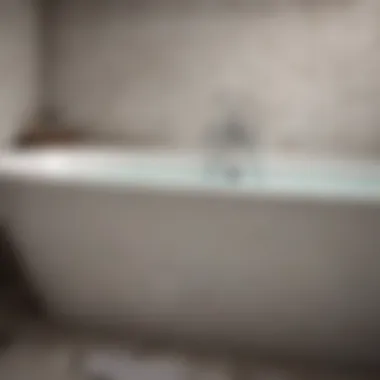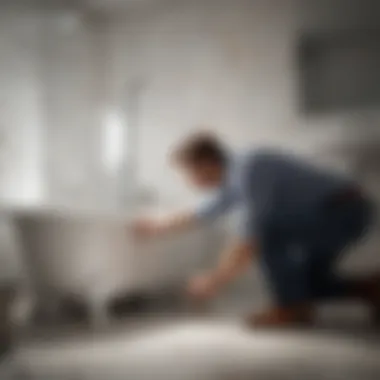Expert Tips to Unclog Your Bathtub Effectively


Intro
Dealing with a clogged bathtub is a common experience for many homeowners. Whether it’s due to hair, soap scum, or other debris, understanding how to address the issue efficiently is crucial. In this article, we offer a comprehensive guide on methods for unclogging bathtubs. Our aim is to equip you with the knowledge to diagnose the problem, explore various unclogging techniques, and determine when it might be necessary to seek professional help.
Understanding the Causes of Clogs
Identifying the source of the clog is the first step in solving the issue. Common causes include:
- Hair Accumulation: Hair is one of the primary culprits behind bathtub clogs. It often combines with soap residue and other debris to create a blockage.
- Soap Scum Buildup: Over time, soap residue can solidify, leading to significant clogs in the bathtub drain.
- Foreign Objects: Small items may accidentally fall into the drain, obstructing flow and causing a blockage.
- Mineral Buildup: Hard water can lead to mineral deposits accumulating inside pipes, contributing to clogs.
Knowing these causes will help you choose the right approach for unclogging.
Assessment Techniques
Before applying a solution, assess the severity of the clog. Simple methods include:
- Visual Inspection: Look into the drain to identify any visible obstructions.
- Water Test: Run the water for a minute or two to observe if it drains slowly or not at all.
- Check Overflows: Make sure the overflow is not blocked; this can also affect the drainage process.
Unclogging Methods
DIY Techniques
Most clogs can be handled with simple tools and materials. Here's how:
- Plunger: A plunger can create enough pressure to dislodge minor blockages. Ensure there is enough water in the tub to cover the plunger cup, and use a firm motion to plunge.
- Plumbing Snake: A plumbing snake can reach deep clogs. Insert the snake into the drain, turning the handle to break up the blockage.
- Baking Soda and Vinegar: Pour half a cup of baking soda followed by half a cup of vinegar down the drain. Wait for thirty minutes, then flush with hot water. This method can help dissolve organic matter.
When to Seek Professional Help
If the clog persists despite your best efforts, it may be time to call a professional plumber. Consider this option when:
- You notice recurring clogs.
- There are signs of water backup in other areas of your home.
- You suspect the problem is deeper in the plumbing system.
"Preventative maintenance is key. Regularly remove hair and clean the drains to avoid future clogs."
End
Understanding how to effectively tackle bathtub clogs empowers homeowners to maintain their plumbing systems. It involves recognizing the causes, employing practical assessment methods, and using either DIY techniques or professional services when needed. Clogs are a common issue, but with the right knowledge, they can be managed efficiently.
Understanding Bathtub Clogs
Understanding bathtub clogs is essential for any homeowner. These clogs not only disrupt your bathing routine but can also lead to larger plumbing issues if not addressed promptly. Recognizing the common causes of clogs and their impact on plumbing systems can save time, money, and frustration.
Identifying the source of a blockage early allows for effective intervention. Homeowners who understand the nature of clogs can make informed decisions about whether to tackle the problem themselves or seek professional assistance. Furthermore, knowledge of clogs can guide preventive measures that help maintain the functionality of plumbing over time.
Definition and Common Causes
A bathtub clog is a blockage that prevents water from draining effectively. This blockage can stem from various sources. One of the most common causes is hair accumulation. Hair can easily collect in the drain over time, combining with soap and products to form a dense mass. This mass can restrict water flow significantly.
Another frequent cause is soap scum buildup. Soap residue combined with minerals from hard water creates a sticky substance that adheres to pipes. Over time, this can narrow the drain's opening and hinder drainage.


Foreign objects, such as toys or personal items, can also cause unforeseen clogs. These items can become lodged in plumbing and block the path of water.
Impact of Clogs on Plumbing Systems
The impact of clogged bathtubs extends beyond mere inconvenience. Persistent clogs can lead to backups in plumbing, which not only affects the bathtub but may also disrupt other fixtures in the house. Decreased water pressure and increased wear and tear on plumbing systems may occur as water struggles to flow past blockages.
Moreover, neglected clogs can result in more severe plumbing issues, such as leaks. These leaks can cause costly damage to your home, including water damage to floors and walls or even mold growth.
While a small clog might seem manageable, it often signals a deeper problem.
Proactively addressing clogs can preserve the integrity of plumbing and ensure a comfortable home environment. Understanding the basics of clogs is crucial for effective home maintenance.
Identifying the Type of Clog
Identifying the type of clog is a crucial step in the process of unclogging a bathtub. The method you choose to address the blockage often depends on its underlying cause. When you comprehend the specific nature of the clog, you can select the most effective tools and techniques to resolve the issue. This understanding not only saves time but can also prevent potential damage to your plumbing system, which can become significant with incorrect handling. Recognizing the indicators and knowing what to look for is vital for a successful unclogging endeavor.
Hair Accumulation
Hair accumulation is one of the most common causes of bathtub clogs. It gathers in the drain over time, often combining with soap and other debris, resulting in a dense blockage. Hair has a tendency to form a sticky mat that traps other particles, leading to a more severe clog.
It is essential to regularly inspect the drain for hair buildup. A simple visual check can help determine if hair is visible in or around the drain. If water drainage slows down after a shower, this is a significant sign that hair accumulation may be the culprit. Using a drain cover can prevent a lot of hair from entering the drain, but it is important to clean it frequently to avoid overflow. Regularly removing visible hair can extend the time between major clogs.
Soap Scum Buildup
Soap scum buildup can also contribute heavily to bathtub clogs. As soap dissolves, it does not fully wash away and instead tends to accumulate on the drain’s interior walls. Over time, this soap residue combines with oils and minerals from the water, creating a sticky mass that can inhibit proper drainage.
To address soap scum, observe if there is a slimy texture in the bathtub or near the drain. Regular maintenance and cleaning with appropriate cleaners can minimize this effect. Certain commercial products specifically target soap scum, but you can also use natural solutions like vinegar combined with baking soda to dissolve these residues. Understanding the presence of soap scum can assist in developing a proactive cleaning schedule, keeping your bathtub draining efficiently.
Foreign Objects
Occasionally, foreign objects can be a cause of clogs in the bathtub drain. Items such as small toys, jewelry, or bathroom items may accidentally fall into the tub and block the drain. Identifying foreign objects can often be straightforward; if you hear a clunking sound or notice the water draining slower, it may be time to investigate further.
To minimize the risk of foreign objects causing trouble, it’s wise to keep the bathtub area free of unnecessary items. Additionally, using a drain cover can protect against larger items entering the drain. However, if an object is stuck, utilizing a drain snake or similar tool can help retrieve it.
In summary, accurately identifying the type of clog is an important first step in resolving bathtub drainage issues. Understanding several causes, like hair accumulation, soap scum buildup, and foreign objects enables you to choose the right approach to clear the blockage effectively.
Tools and Materials Needed
Understanding the tools and materials needed to unclog your bathtub is crucial for an effective DIY approach. Having the right equipment saves time and effort while increasing the chances of resolving the issue efficiently. Proper preparation can also help in preventing any potential damage to pipes or fixtures during the unclogging process.
Basic Tools for DIY Solutions
To start, some basic tools are essential for anyone looking to unclog their bathtub. These tools can often be found in most households or purchased at local hardware stores. Here are some of the specific tools you may require:
- Plumber’s Plunger: This is a fundamental tool for unclogging drains. A standard plunger can generate enough pressure to dislodge minor clogs, especially those caused by hair or soap scum.
- Drain Snake: Also known as a drain auger, this tool is effective in reaching deeper clogs that a plunger may not dislodge. Drain snakes come in various lengths, allowing them to navigate through pipe bends and curves.
- Bucket: A simple bucket can be useful for collecting excess water and debris. It can also serve to provide a clean workspace.
- Gloves: Protecting your hands with gloves is important, particularly when dealing with unpleasant substances that may emerge from the drain.
- Screwdriver: This tool may be needed to remove drain covers or access specific plumbing components in the bathtub.
By utilizing these basic tools, a homeowner can tackle most common bathtub clogs without requiring professional assistance.
Chemical Drain Cleaners


In some situations, individuals may opt for chemical drain cleaners to aid in unclogging their bathtubs. These products are designed to dissolve common types of clogs, mainly those made from grease, hair, and soap residues.
However, there are important considerations when using chemical drain cleaners:
- Use With Caution: Chemical drain cleaners can be harsh and may damage pipes if used excessively. It’s best to follow the manufacturer's instructions.
- Environmental Impact: Many commercial drain cleaners contain chemicals that can be harmful to the environment. Consider this when choosing products and explore alternatives.
- Safety Precautions: It is important to wear gloves and eye protection when handling these cleaning solutions, as they can cause serious injury if mishandled.
Given their effectiveness, these cleaners can be an option but should be used judiciously.
Natural Alternatives
For those who prefer a more eco-friendly approach, there are natural alternatives to chemical drain cleaners. These options are usually made from household items and can be effective at clearing mild clogs. Some popular natural techniques include:
- Baking Soda and Vinegar: This combination creates a bubbling reaction that can help loosen debris buildup. Pour half a cup of baking soda down the drain, followed by half a cup of vinegar, and let it sit for about 30 minutes.
- Salt and Hot Water: Pouring a mixture of salt and hot water may help dissolve soap scum and grease. Use about a half cup of salt followed by boiling water.
- Dish Soap: If the clog is primarily due to greasy buildup, mixing dish soap with hot water can help to break it down and dissolve stubborn clogs.
Using natural alternatives not only reduces chemical exposure but can also be kinder to plumbing systems.
Always remember to assess the type of clog before selecting a method. Different solutions may work better for specific issues.
DIY Methods to Unclog Your Bathtub
In the context of tackling bathtub clogs, employing DIY methods holds significant value. First, the basic benefit lies in saving money, as hiring a plumber can be costly. Homeowners often have at least some tools available at home, making initial attempts to clear blockages feasible without needing professional help. Furthermore, DIY methods allow for flexibility and immediacy. A clog may occur at inconvenient times, and having the knowledge to address it promptly can prevent further complications. Moreover, these techniques provide a sense of empowerment and satisfaction when they work effectively. Understanding various methods enables one to adapt to specific situations, which is crucial for efficient unclogging.
Boiling Water Technique
Using the boiling water technique is one of the simplest yet most effective methods for unclogging a bathtub. This method is particularly useful for resolving minor clogs, especially those caused by soap scum and grease. To apply this approach, start by boiling a kettle filled with water. Once it reaches a rolling boil, carefully pour it directly into the drain in stages. Wait a few seconds between pours to allow the hot water to break down any buildup. This method is effective and inexpensive, requiring only water and access to heat. However, ensure that your pipes are not made of PVC, as boiling water can potentially cause damage.
Plunger Use
When most people think about unclogging drains, the plunger often comes to mind. Utilizing a plunger on your bathtub can be an efficient way to tackle stubborn clogs. Make sure to use a flange plunger, as it is designed specifically for drains. To begin, seal the overflow drain with a wet rag to create a better suction seal. Apply forceful plunges to create pressure that will loosen the blockage. This trial may take a few attempts, and persistence is key. It’s crucial to remain careful not to damage the drain or tub. Keep in mind that a plunger works best on clogs made of hair or soap scum rather than those involving foreign objects.
Use of a Drain Snake
A drain snake, also known as a plumber's snake, is another valuable tool for unclogging bathtubs. This device is flexible and can reach far into plumbing systems. To use a drain snake, insert it into the drain while rotating it clockwise to hook and dislodge any blockage. Once you feel resistance, proceed to push forward gently and pull it back with a slight twist. It's important to wear gloves as you may collect debris along the way. If the clog is particularly stubborn, employing this method more than once may yield better results. The drain snake is effective, but it requires a bit of practice to master.
DIY Baking Soda and Vinegar Method
The combination of baking soda and vinegar is a classic home remedy for unclogging issues. This method capitalizes on the reaction between the two substances, which creates gas that can help break down buildup. Start by pouring about half a cup of baking soda down the drain, followed by an equal amount of vinegar. Immediately cover the drain to trap the reaction inside. After letting it sit for approximately 30 minutes, flush the drain with hot water. This method is not only environmentally friendly, but it is also an efficient way to tackle clogs without resorting to harsh chemicals. However, results may vary depending on the severity of the clog.
When to Consider Professional Help
Homeowners often initiate efforts to clear a clogged bathtub on their own. However, there are circumstances that necessitate the expertise of a plumbing professional. Recognizing these situations is crucial for both effective problem resolution and the prevention of further damage. Professional plumbers possess specialized tools and knowledge that can address issues beyond the scope of standard DIY methods. They can also provide insights on long-term solutions to prevent recurring clogs.
Signs Indicating a Serious Issue
Several indicators suggest that a clog may stem from serious plumbing issues that require professional intervention:
- Persistent Clogs: If a bathtub continuously clogs shortly after clearing it, this might hint at a deeper issue in the plumbing system.
- Slow Draining: Water that drains sluggishly—even after attempting various home remedies—could suggest a build-up deep in the pipes.
- Multiple Clogs: If clogs are occurring in multiple drains throughout your home, this can indicate a systemic problem in your plumbing.
- Unpleasant Odors: Foul odors emanating from the drain may suggest trapped debris or more severe issues like sewage backup.
- Wet Spots: If you notice wet spots around your floor or hear unusual sounds coming from pipes, this could signify a leak that may require professional assessment.
Awareness of these signs is vital. Ignoring them might lead to more significant, costly repairs in the future.


Cost Implications of Professional Services
While involving a professional plumber may seem costly initially, it often saves more money down the line. The costs can vary significantly based on several factors:
- Scope of the Problem: Each plumbing issue has a unique solution, which can affect the overall cost. Basic clogs might be less expensive while major repairs or replacements may incur higher charges.
- Location: Plumbers in urban areas often charge more due to higher demand and cost of living. In contrast, rural plumbers may offer lower rates.
- Complexity of the Job: For instance, if specialized equipment is necessary, this can increase the overall bill.
- Time Required: Short jobs can be relatively inexpensive, but more extensive work may lead to higher hourly rates.
Engaging a professional offers a reliable assessment of plumbing issues, helping you avoid potential hazards, while providing long-lasting solutions.
Preventive Measures to Avoid Future Clogs
Preventing bathtub clogs is a crucial aspect of maintaining a functional plumbing system. By implementing certain measures, homeowners can save themselves from the hassle and expense of dealing with clogs. Prevention reduces stress, time, and costs associated with potential plumbing issues.
Regular Cleaning Routines
Establishing regular cleaning routines can significantly help in safeguarding against clogs. Cleaning the bathtub and drain should not just be a seasonal chore. Rather, it’s beneficial to clean them weekly or at least bi-weekly.
During these cleaning sessions, you can remove hair, soap scum, and other debris. Using tools like a soft brush or cloth can help in this process. Pay special attention to areas around the drain. Removing these substances before they accumulate can minimize the chances of blockages.
You might also consider using mild cleaning solutions. Avoid harsh chemicals that might damage plumbing fixtures. Gentle cleansers can effectively break down soap scum while being safer for pipes.
Installation of Drain Covers
Another effective preventive measure includes the installation of drain covers. These covers act as barriers, capturing debris that can lead to clogs. They can stop hair and other small particles from slipping down the drain.
When selecting a drain cover, look for one that is easy to clean and durable. There are various types available, from simple mesh screens to more elaborate designs that suit your bathroom decor. Proper installation of these covers can be a simple but impactful step in reducing future clogging.
Adopting Good Practices
Adopting good practices during everyday use of the bathtub is also critical. Make it a point not to rinse off excess products down the drain. This includes leftover shampoo, conditioner, or any other substances. These products can contribute to soap scum accumulation.
Encourage family members or housemates to do the same. Education on what should and should not go down the drain can foster better habits.
Lastly, periodically inspecting the plumbing system for signs of wear or blockage can be helpful. If there are signs of leakage, slow drainage, or unusual sounds, address those problems early. Taking these proactive steps can ensure a smoother bathing experience.
Engaging in preventive measures today can spare you from costly repairs tomorrow.
Closure
In this concluding section, it is crucial to underscore the importance of effective bathtub maintenance and the role that understanding and managing clogs plays in preserving plumbing health. This article has guided homeowners through the complexities associated with bathtub clogs, offering various methods to address the issue. Addressing clogs not only improves the functionality of the bathtub but also helps prevent drastic plumbing problems that could result in costly repairs.
Recap of Key Points
To cement your understanding of how to best tackle and prevent bathtub clogs, let’s summarize the main points:
- Understanding Bathtub Clogs: Recognizing types of clogs, such as hair accumulation and soap scum buildup, is the first step in diagnosis.
- Identifying the Type of Clog: Knowing whether the issue is due to foreign objects or a particular buildup informs your approach.
- Tools and Materials Needed: Having the right tools, whether basic or chemical, set the stage for effective unclogging.
- DIY Methods to Unclog: Various methods exist, from the simple boiling water technique to chemical interventions.
- When to Consider Professional Help: Recognizing signs of severe issues can save time and money.
- Preventive Measures: Regular cleaning routines and good practices can significantly reduce the occurrence of clogs.
By reviewing these core concepts, homeowners can feel more empowered in their ability to maintain their bathtubs wisely.
Final Thoughts on Bathtub Maintenance
Maintaining a bathtub extends beyond just unclogging. It involves a holistic approach that includes regular inspections, timely interventions for early signs of issues, and recognizing the importance of quality materials in plumbing systems. Investing effort into proper maintenance can enhance the longevity of plumbing fixtures and overall home value.
Moreover, adopting preventive measures is key in fostering a smoother experience in your bathroom. Think about employing drain covers to catch debris or committing to a cleaner regime.
Homeowners are encouraged to internalize the importance of regular maintenance not just as a chore, but as a means of preserving both comfort and investment. When investing time now, it pays off in the long run, ensuring future enjoyment and savings in repairs.







